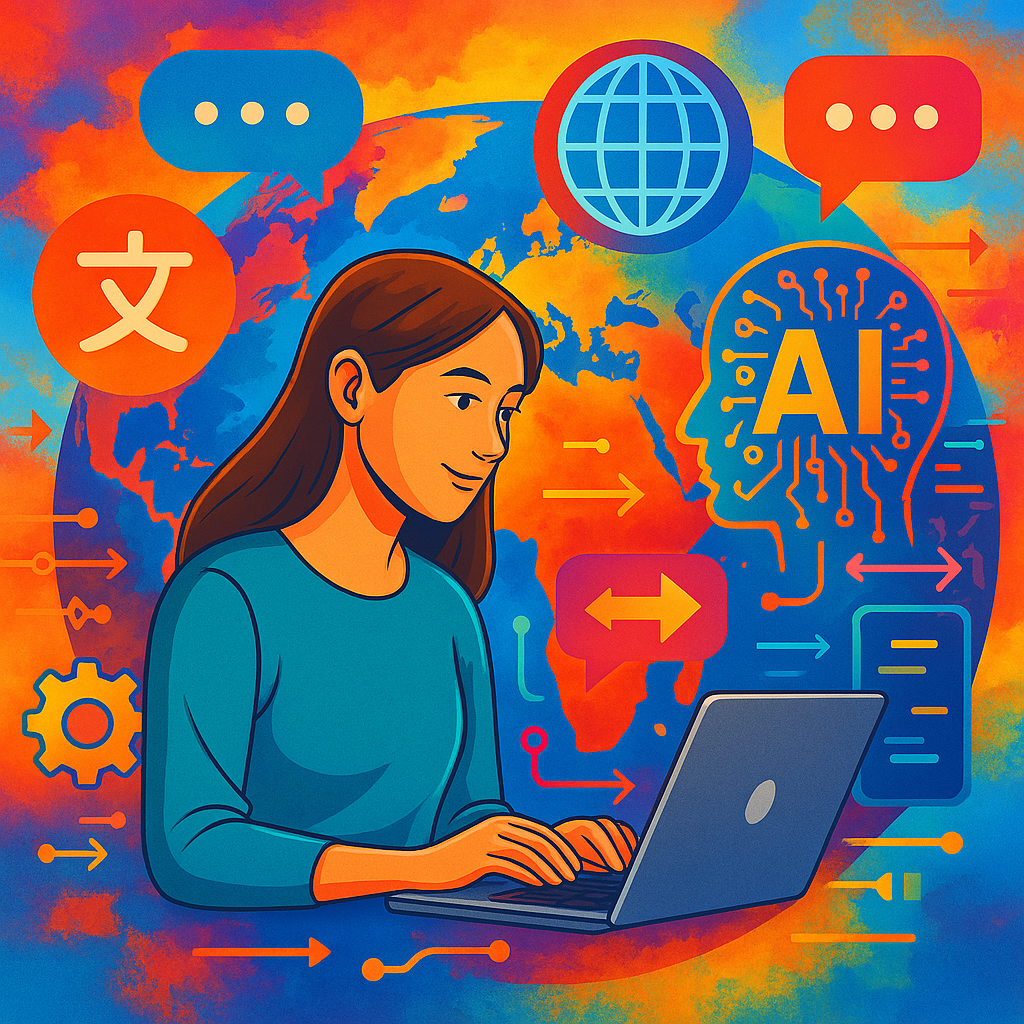Benefits of AI in Translation: Breaking down linguistic boundaries has never been more crucial in today’s hyperconnected world, and artificial intelligence is driving the change. Beyond mere convenience, artificial intelligence is drastically changing our communication, business, and personal interactions with people from many backgrounds.
From flawless text translation in dozens of languages to real-time speech interpretation, artificial intelligence solutions are enabling people and companies to participate globally with confidence.
AI-driven translation opens doors to new possibilities and promotes global understanding like never before, whether your company is growing abroad or you are a visitor negotiating unfamiliar streets.
1. AI Breaking Language Obstacles: A New Communication Era
Imagine a time when knowing any language does not hamper one another. Artificial intelligence (AI) is helping that ambition become ever more realistic. AI-driven translation systems are revolutionizing international and cultural communication. AI is enabling faster than ever before the breakdown of language barriers, from real-time translations on cellphones to automatic subtitles in web videos.
We primarily depended on human translators and simple phrase-based technologies until artificial intelligence became a powerhouse in translating. Although expert translators are still invaluable in some situations, such as legal documents or literature, AI has developed quickly to manage regular translations with surprising accuracy. By recognizing context, syntax, and semantics, tools like Google Translate and Deep learn languages much as the human brain does—that is, via neural machine translation (NMT). This provides them a significant advantage over more antiquated, rule-based algorithms that just replaced one word at a time.
AI is unique in that it can learn the small differences across languages by processing enormous amounts in several languages. Thus, absorbing AI models today have a far better grasp of how to translate meaning than just words, whether that means industry-specific jargon, idioms, or slang. This capacity has enabled people and companies to connect more successfully globally. For instance, a Brazilian business can now present to Japanese investors without employing a specific translator. That is the ability of artificial intelligence to act.

2. From Smartphones to Social Media, AI in Everyday Translation Tools
Consider how often you use translation tools every day—reading product reviews on AliExpress, browsing Instagram captions in another language, or corresponding with an international acquaintance. Translation driven by artificial intelligence has crept into our lives practically without our awareness. Now, tools like Google Lens enable you to point your camera at a sign, menu, or even a handwritten note to get a translated version overlaid on your screen quickly. That is artificial intelligence, not science fiction.
Apps like WhatsApp and Facebook Messenger also include AI-based translating tools, which let you talk with someone in a totally different language without copying and pasting text into another app. It is straightforward. Automatic subtitles and real-time translations help make material on social media sites like YouTube and TikTok accessible to a worldwide audience. This is not only important for social contact but also for educational goals, thereby extending the reach of knowledge and learning resources beyond boundaries.
Additionally, voice assistants Siri, Alexa, and Google Assistant are improving their game. Natural language processing driven by artificial intelligence allows them to recognize and translate spoken words with rather good accuracy. Therefore, if you are abroad and require instructions or a meal order, you can just talk into your phone and let AI do the rest.
Although these technologies are not perfect, they are absolutely essential for millions of people because of their simplicity and ongoing development. They are quite useful for travelers, digital nomads, and companies handling foreign customers specifically. Even better? These systems learn over time; hence, the more we use them, the better they become at faithfully and intuitively translating.
3. Business and Global Markets AI Translation
Small and large companies are using artificial intelligence to improve customer experience and simplify worldwide operations. AI translation solutions are saving time, money, and effort, whether they are localizing a website, translating product manuals, or managing customer service in several languages.
Consider internet behemoths like eBay or Amazon. To let consumers purchase in their local tongue, they automatically translate product descriptions, reviews, and customer questions using artificial intelligence. Along with improving accessibility, this raises confidence and conversion rates. Likewise, SaaS businesses localize their product interfaces and assist documentation using artificial intelligence instead of assembling sizable translation teams.
Multilingual chatbots driven by artificial intelligence can help consumers from several language backgrounds in real-time customer service. Therefore, even if the company’s support staff works out of India or the United States, a client in Spain can pose a question in Spanish and obtain a coherent answer. It improves user experience and is relatively cheap.
Furthermore, in sectors such as legal, healthcare, and finance, where accuracy and clarity are critical, artificial intelligence facilitates rapid document translations. In these situations, human review is still crucial, but artificial intelligence speeds up the initial process and lowers the labor burden. To literally keep everyone on the same page—that is, to automate internal communication across worldwide branches—some businesses even include artificial intelligence translation technologies in their workflow systems.

4. Problems and Restraints of AI in Translation
When it comes to perfect translation, artificial intelligence, notwithstanding its amazing advancement, has a long road ahead. Understanding cultural background and tone is among the toughest challenges. Translation often loses irony, comedy, or emotional subtleties, for example. In English, a joke that’s funny could go absolutely flat—or worse—in Japanese or Arabic.
Then there is the matter of linguistic variety. AI technologies struggle with less popular languages or dialects, particularly those with little training data, even if they perform well in frequently spoken languages such as English, Spanish, and Mandarin. AI translation systems, therefore, typically benefit communities speaking indigenous or minority languages less.
Privacy and security also worry me. Sensitive documents or conversations translated via online AI translators can be dangerous, as data can be retained or misused. Companies managing private data must be very careful and frequently turn to on-site artificial intelligence technologies to help reduce these threats.
Real-time translation—especially for voice—adds another constraint. Although tools like Google Meet or Microsoft Teams provide live translation, occasionally they misread technical words, background noise, or accents. In a judicial deposition or a fast-paced corporate meeting, these little mistakes might cause major misinterpretation.
The field is still developing, though. Researchers are always developing better models, and more recent systems like OpenAI’s GPT-4 demonstrate encouraging translation accuracy and contextual awareness. Human translators will still be extremely important, particularly in high-stakes situations, even until artificial intelligence can completely replicate human knowledge.
5. AI’s Future in Translation: Link to Real Globalization
Looking ahead, artificial intelligence in translating is about inclusiveness and empowerment rather than only convenience. AI should close even more linguistic gaps as machine learning models grow more sophisticated and training data gets more varied. Universal translators buried in wearable devices or augmented reality glasses could enable us to understand anyone, anywhere, in real time, going forward.
Startups developing brain-computer interfaces and immersive AI-powered translation systems are already glimpsing this future. No earphones, no delays, no language instruction required; soon, you could find yourself walking into a conference room with speakers from ten different countries and completely understanding everyone.
Moreover, artificial intelligence can distribute knowledge. Instant translations of textbooks, medical instructions, legal rights, and even government services provide non-native speakers with equitable access to vital tools. AI is translating opportunity rather than merely words in some sense.
Still, the road will call for ethical responsibilities, particularly in keeping accuracy, justice, and data privacy. AI in translation aims to improve our capacity to communicate, cooperate, and comprehend across linguistic barriers rather than to replace humans.
Language ought to be a window rather than a wall, ultimately. That window is now wide open as artificial intelligence drives the revolution.
Conclusion
By allowing cross-languageon to be faster, better, and more accessible, artificial intelligence is changing the translation scene. Artificial intelligence is clearly a linguistic partner, not only a tool, from travel apps to worldwide corporate plans. Although problems still exist, artificial intelligence has unlimited potential to produce a more inclusive and linked planet. The future speaks multiple languages; with artificial intelligence, so can we.




